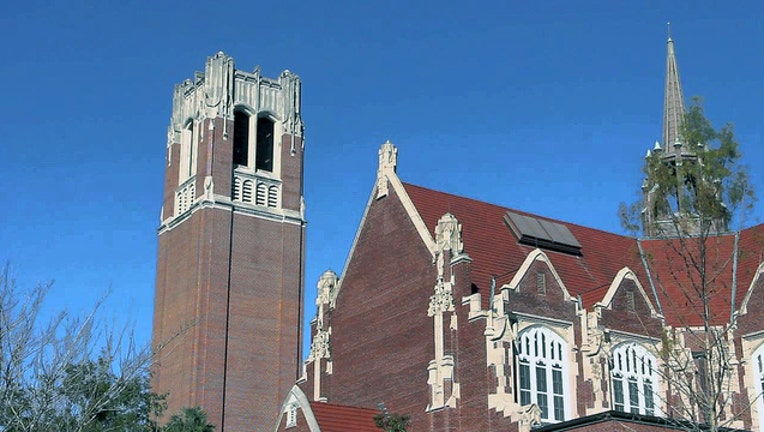State looking at rising university debt

Century Tower at the University of Florida campus in Gainesville, Florida. [Photo courtesy: UF]
TALLAHASSEE, Fla. (NSF) - While state debt has declined 9.5 percent over the past five years, debt for Florida's state universities has risen by 41 percent, according to a report reviewed Tuesday by Gov. Rick Scott and the Cabinet.
State debt has fallen by $2.7 billion in that period, for a total debt of $25.5 billion at the end of 2015. In the same time, university debt has risen by $1.1 billion, for a total of $3.8 billion, the state Division of Bond Finance report showed.
The bulk of university debt is tied to borrowing by "direct support organizations," university-based entities that have borrowed money for health-care facilities, student housing, parking garages, fitness-wellness centers and athletic facilities.
One major factor is health-care debt, which has doubled over the past five years to $1.23 billion. The University of Florida has the most debt at $1.35 billion, led by borrowing related to UF Health Shands Hospital and related facilities.
Borrowing by the direct support organizations began in 1994. Over the subsequent two decades, the Legislature, the university system's Board of Governors and the executive branch have taken steps to regulate the process, including passage of a 2006 law that created two methods for allowing universities to borrow money.
One was the traditional process where the borrowing was arranged by the Division of Bond Finance with approval by the governor and Cabinet.
The second method allowed borrowing more directly by state universities using the direct support organizations, subject to approval by the Board of Governors.
Debt control has been a fundamental issue for Scott, who took office in 2011. Under his direction, more debt-control policies were initiated in 2013, including requiring an analysis of the return on investment and cost assessment of issuing debt.
"The whole reason for the change in policy and the justification of debt is to enhance accountability and transparency whenever debt is being used," said Ben Watkins, director of the Division of Bond Finance.
The $1.1 billion increase in university debt during the five-year period included $423 million under Scott's watch, with the bulk of that coming from borrowing by the direct support organizations, which were not subject to approval by Scott and the Cabinet. But the report showed even with that rise, university borrowing has slowed under Scott compared to longer-term borrowing trends.
The direct-support organization borrowing sparked some controversy last spring when state officials learned that $15.6 million in bonds issued by the University of North Florida in 2010 for a sports-wellness center had been downgraded by financial analysts.
It led to a new round of borrowing reforms, including a requirement that the Board of Governors and the Division of Bond Finance receive notice of rating changes on bonds issued by the direct support organizations.
"The bottom line is a lot has been done to enhance oversight regarding any debt proposals and the Board of Governors has actively engaged in that exercise," Watkins said.
Watkins said the revised debt policies, which also include the use of public-private partnerships by the universities, now provide a "framework for adequate oversight" of university borrowing.
However, one exception is borrowing related to UF Health Shands Hospital, which as an older institution borrows money under a framework established prior to the use of direct support organizations.
"From a debt management perspective, that's a bit of a blind spot because there is no review process in place," Watkins said. "Either the Board of Governors or the governor and Cabinet should be responsible for evaluating the Shands health-care debt and applying the policies that are applicable to all state agencies including universities."
In a second recommendation, Watkins called for more scrutiny by the boards of trustees at each university when they are reviewing borrowing proposals by the direct support organizations.
Watkins said the local boards should apply the same standards that will later be used by the Board of Governors when reviewing the borrowing.
"So that in effect the deal has been scrubbed down and the hard questions have been asked early on in the process rather than waiting until it floats up to the Board of Governors for purposes of review," Watkins said.
University system Chancellor Marshall Criser said the Board of Governors has already amended its debt policies with the requirement that the local boards of trustees as well as the boards of the direct support organizations use the same debt standards as the Board of Governors and the governor and Cabinet.
"That decision-making process from its beginning to its end is subject to the same standard of review and will have the same due diligence and fiduciary responsibility embedded in it so that we understand this conversation from beginning to end," Criser said.
Criser said in his preliminary discussions with University of Florida officials, they are open to changes in the borrowing policies related to Shands.
But Criser said the Board of Governors would look at a borrowing policy that would not only impact Shands but could be applied to other institutions, including the University of Central Florida, which is working on a proposal for a new teaching hospital.
Agriculture Commissioner Adam Putnam said he wanted to hear from the University of Florida officials before the state adopts a standard that could impact the Gainesville teaching hospital as well as other major health centers in the state.
"We need to get this right. It's a big deal for us," Putnam said. "I just want to hear both sides before we just toss the hot potato into the BOG's (Board of Governors') lap."
Criser said the Board of Governors would likely take up the university borrowing issue at its January meeting, with the issue returning to Scott and the Cabinet in February.
Information provided by The News Service of Florida.

